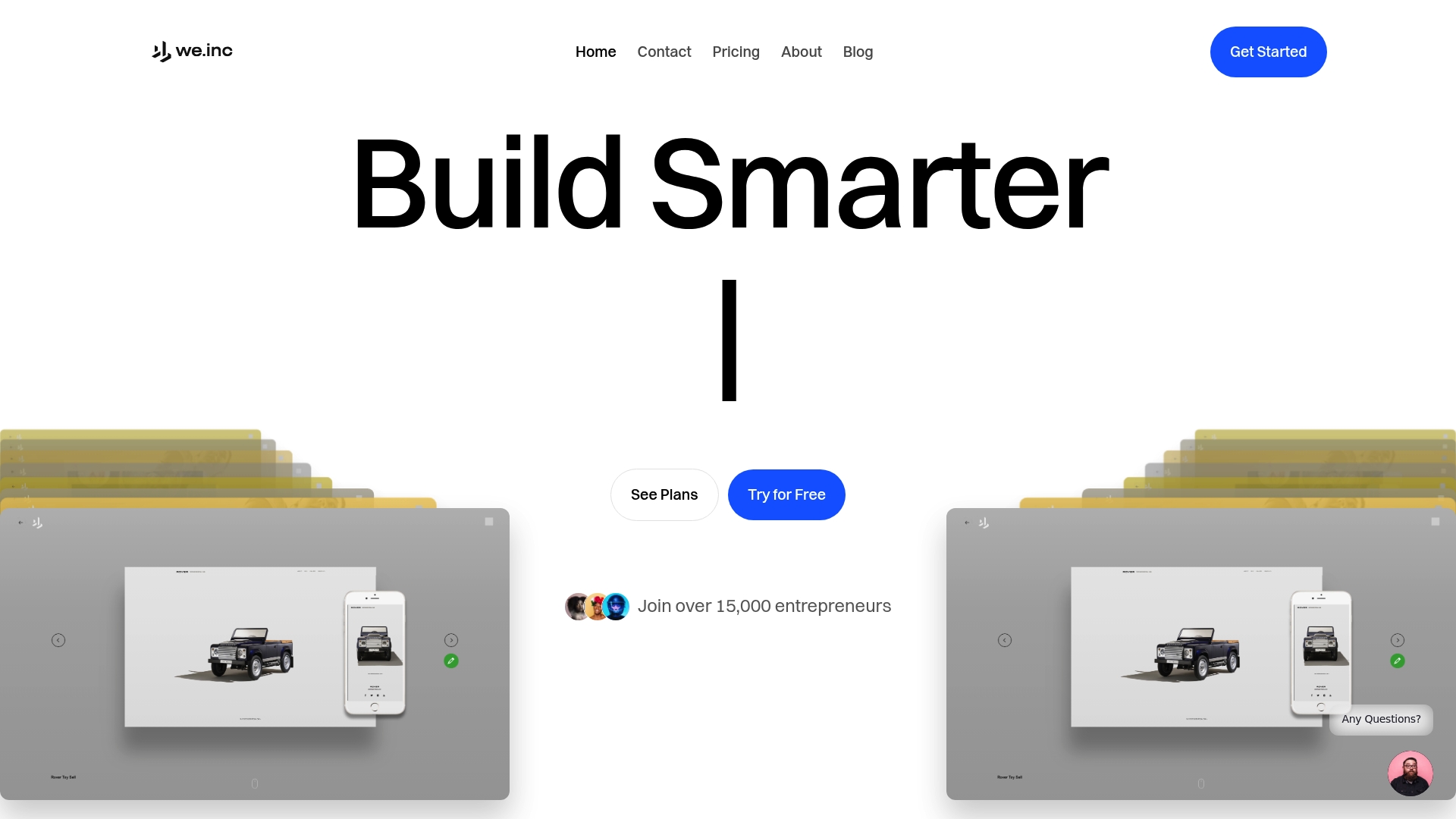The Essential Guide to Visual Website Builders

Over 60 percent of new business websites are now launched with visual website builders. This shift is reshaping how entrepreneurs and small businesses go online. Instead of wrestling with complex code, anyone can quickly design a professional website using easy tools and modern templates. As digital competition heats up, knowing how these platforms work can help you create an impactful web presence with less time and stress.
Table of Contents
- Defining Visual Website Builders and Core Concepts
- Types of Visual Website Builders Explained
- Key Features and Functionalities for Users
- Real-World Applications for Businesses and Agencies
- Comparing Visual Builders With Traditional Methods
- Cost, Benefits, and Common User Mistakes
Key Takeaways
| Point | Details |
|---|---|
| Empowerment through Simplification | Visual website builders democratize web design, enabling users with minimal technical skills to create professional websites efficiently. |
| Types of Builders | Visual website builders are categorized into adaptive and responsive types, affecting content scaling and user experience based on device compatibility. |
| Cost-Effective Solutions | These platforms offer flexible pricing models and fast deployment, reducing upfront investments for small businesses and entrepreneurs. |
| Common User Pitfalls | Users should focus on mobile responsiveness, SEO optimization, and clear visual hierarchy to maximize the effectiveness of their digital presence. |
Defining Visual Website Builders and Core Concepts
Visual website builders are digital platforms that empower entrepreneurs, small business owners, and digital professionals to create professional websites without requiring advanced coding skills. According to research from web design resources, these tools provide graphical interfaces that simplify web development through intuitive drag-and-drop mechanisms.
At their core, visual website builders transform complex web design processes into accessible, user-friendly experiences. Users can select pre-designed templates, customize layouts, and integrate multimedia elements using point-and-click interactions. Why Use Website Builders: Complete Guide for 2025 reveals that these platforms democratize web design, allowing individuals with minimal technical expertise to launch compelling digital presences.
Key characteristics of visual website builders typically include:
- Drag-and-drop interface design
- Pre-built professional templates
- Responsive mobile design capabilities
- No coding knowledge required
- Integrated hosting and domain options
- Real-time editing and previewing
The fundamental philosophy behind visual website builders is empowerment through simplification. By removing technical barriers, these platforms enable entrepreneurs to quickly transform their digital vision into functional, attractive websites without investing significant time or resources in traditional web development processes.
Types of Visual Website Builders Explained
Visual website builders can be categorized into two primary design approaches: adaptive and responsive website builders. According to research from web design resources, these platforms offer distinct strategies for creating websites that look great across different devices and screen sizes.
Adaptive website builders create fixed designs tailored for specific screen dimensions. This approach involves developing multiple versions of a website, each optimized for different device types like desktop, tablet, and mobile. 7 Essential Types of Business Websites Every Entrepreneur Should Know highlights how these builders can provide precise control over how content appears on various screens.
Key characteristics of visual website builder types include:
- Adaptive Builders:
- Multiple fixed layouts
- Specific designs for different devices
- Precise control over appearance
- Responsive Builders:
- Flexible, fluid layouts
- Automatic content scaling
- Single design that adapts universally
Responsive website builders take a more dynamic approach, using flexible layouts that automatically adjust and scale content across any screen size. These platforms eliminate the need for multiple design versions by creating a single, intelligent design that seamlessly transforms based on the viewing device. This approach provides a more streamlined development process and ensures consistent user experience across all platforms.
Here’s an overview comparing adaptive and responsive visual website builders:
| Attribute | Adaptive Builders | Responsive Builders |
|---|---|---|
| Layouts | Multiple fixed layouts Device-specific designs |
Flexible, fluid layouts Single universal design |
| Content Scaling | Manual adjustment per device | Automatic scaling across devices |
| Control Over Design | High precision by screen size | Consistent yet less granular |
| Development Effort | Separate versions for each device | One design adapts to all |
| User Experience | Optimized per device More upkeep |
Seamless on any device Less maintenance |
Key Features and Functionalities for Users
Visual website builders offer an extensive array of features designed to simplify and enhance the web design process for entrepreneurs and digital professionals. According to research from web design resources, these platforms provide intuitive tools that transform complex website development into an accessible, user-friendly experience.
The core functionalities typically include drag-and-drop interfaces that allow users to create and customize websites without requiring advanced coding skills. Step by Step Website Launch Guide for Entrepreneurs emphasizes how these platforms empower users to rapidly prototype and launch professional-looking websites through advanced design capabilities.
Key features and functionalities include:
- Design Tools:
- Drag-and-drop interface
- Customizable templates
- Real-time editing
- Mobile-responsive design
- Technical Capabilities:
- Integrated SEO optimization
- AI-powered design assistance
- E-commerce integration
- Analytics and tracking tools
Advanced website builders go beyond basic design, offering sophisticated functionalities like AI-powered design suggestions, comprehensive SEO tools, and seamless e-commerce integration. These features enable entrepreneurs to create not just visually appealing websites, but also highly functional digital platforms that can effectively support business growth and online presence.

Real-World Applications for Businesses and Agencies
Visual website builders have transformed how businesses and agencies approach digital presence, offering powerful solutions for quick and efficient online deployment. According to research from web design resources, these platforms enable organizations to establish compelling digital footprints without extensive technical expertise.
For small businesses, these tools provide critical capabilities for rapid market entry. How to Build Agency Website for Fast Client Onboarding demonstrates how digital platforms can streamline client acquisition and showcase professional capabilities. Entrepreneurs can now create sophisticated websites that previously required significant investments in design and development.
Practical applications across different business contexts include:
- E-commerce Platforms:
- Product showcases
- Online shopping experiences
- Integrated payment systems
- Professional Services:
- Portfolio websites
- Service offering pages
- Client testimonial integration
- Agency Solutions:
- Multi-client website management
- Customizable template libraries
- White-label branding options
Agencies particularly benefit from visual website builders by offering scalable solutions that reduce development time and complexity. These platforms allow professionals to focus on strategic design and client relationships rather than getting bogged down in technical implementation, ultimately delivering more value and faster results for their clients.
Comparing Visual Builders With Traditional Methods
Visual website builders and traditional web development represent two fundamentally different approaches to creating online platforms. According to research from web design resources, these methodologies differ significantly in complexity, time investment, and technical requirements.
Traditional web development relies on manual coding using languages like HTML, CSS, and JavaScript, demanding extensive technical expertise and precision. In contrast, 7 Essential AI Tools for Small Business Growth Success highlights how visual builders democratize website creation by eliminating complex coding barriers.
Key differences between visual builders and traditional methods include:
- Traditional Web Development:
- Requires advanced coding skills
- Offers maximum customization
- Longer development cycles
- Higher development costs
- Visual Website Builders:
- No coding knowledge required
- Pre-designed templates
- Rapid deployment
- Cost-effective solutions
While traditional methods provide granular control and unlimited customization, visual website builders offer speed, accessibility, and user-friendly interfaces. Entrepreneurs and small businesses can now launch professional websites within hours, compared to weeks or months required by conventional web development approaches. The trade-off involves slightly reduced customization potential in exchange for dramatically reduced time and resource investment.
Cost, Benefits, and Common User Mistakes
Visual website builders represent a strategic investment for businesses seeking efficient online presence development. According to research from web design resources, these platforms offer flexible pricing models that accommodate various budget constraints and business needs.
7 Essential AI Tools for Small Business Growth Success emphasizes the critical importance of understanding both the financial and functional aspects of website development tools. Small businesses and entrepreneurs can leverage these platforms to minimize upfront technology expenses while maximizing digital potential.
Key cost considerations and potential pitfalls include:
- Cost Structures:
- Freemium model options
- Monthly/annual subscription plans
- Scalable pricing tiers
- Common User Mistakes:
- Neglecting mobile responsiveness
- Overloading pages with content
- Ignoring SEO optimization
- Poor visual hierarchy
- Strategic Benefits:
- Rapid deployment
- Lower initial investment
- No coding expertise required
- Quick iteration capabilities
Effective use of visual website builders requires strategic planning and awareness of potential limitations. While these platforms dramatically reduce barriers to online presence, users must remain mindful of design principles, performance optimization, and maintaining a clean, user-focused interface that effectively communicates their brand message.
Unlock Effortless Website Creation With Visual Builders and Automation
If you are feeling overwhelmed by the complexity of traditional web development or unsure how to build a fully responsive and engaging website without coding, you are not alone. This article highlights the crucial challenge entrepreneurs and small businesses face: creating professional websites quickly while managing content, SEO, and mobile responsiveness with limited technical skills. Visual website builders solve these pain points by offering drag-and-drop design, adaptive and responsive layouts, and real-time editing features that empower you to launch your digital presence fast.

Experience the power of an all-in-one platform that goes beyond just website building. At We.inc, you get easy-to-use visual website creation integrated with AI-powered marketing automation and social media management in a single dashboard. This unified approach enables entrepreneurs and agencies to build stunning, high-converting websites, automate engagement with AI chatbots, and scale multiple clients effortlessly. Start your journey today at We.inc and discover how rapid deployment and smart automation can become your unfair advantage in the digital marketplace.
Frequently Asked Questions
What are visual website builders?
Visual website builders are digital platforms that allow users to create professional websites without advanced coding skills by utilizing intuitive drag-and-drop mechanisms and pre-designed templates.
How do adaptive and responsive website builders differ?
Adaptive website builders create multiple fixed layouts optimized for specific devices, while responsive website builders use flexible layouts that automatically scale and adjust content for any screen size, providing a seamless user experience.
What key features should I look for in a visual website builder?
Look for features such as drag-and-drop interfaces, customizable templates, mobile responsiveness, integrated SEO tools, e-commerce integration, and analytics tracking to enhance your website’s functionality and design.
What are common mistakes to avoid when using visual website builders?
Common mistakes include neglecting mobile responsiveness, overloading pages with content, ignoring SEO optimization, and having poor visual hierarchy, which can negatively impact user experience and website performance.
Recommended
- Why Use Website Builders: Complete Guide for 2025
- Step by Step Website Launch Guide for Entrepreneurs
- 7 Essential Types of Business Websites Every Entrepreneur Should Know
- Understanding Visual Content Marketing: Key Concepts Explained
- The Best WordPress Page Builders in 2025: Real-World Usage Data from WPoptic - WPoptic
%20(1).svg)


